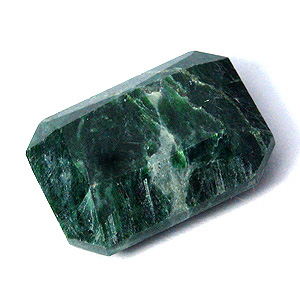Mawsitsit

Mawsitsit
(Emerald cut. 7.93 carat; 14.3 x 10.9 x 4.8mm)
Image © supplied by Freakingcat Gems
Gemstones like the Hope Diamond and the Koh-i-noor Diamond have also given rise to various folklore and legends. But apart from the commercially popular gemstones like emeralds, rubies and sapphires there are other gemstones which though not popular are extremely rare. These gemstones are usually composed of rare earth elements and are collected by gemstone experts and collectors all across the world at high prices which run into hundreds and thousands of dollars for a single carat.
One such gemstone is Mawsitsit. The gemstones of Mawsitsit are extremely rare and unlike other rare gemstones Mawsitsit crystals are rocks and not minerals.
Mawsitsit History & Etymology:
Mawsitsit was first discovered in Tawmaw in the Myitkyina-Moguang District of the Kachin State in Myanmar. Mawsitsit were discovered in the early part of the 1960s near the imperial and historical Jadeite mines located in the northern part of Myanmar. Mawsitsit hence derive their name from the area in which they were first discovered and in honor of the Kachin State in Myanmar.
Mawsitsit is also known as Kosmochlor Jade. Mawsitsit derives its second name, Kosmochlor Jade, from the Greek words kosmisch and chlor. These two Greek words literally translate into cosmic and green respectively. The allusion to cosmic has been made due to the occurrence of Mawsitsit crystals in meteorite rocks and the allusion to the green color is because of the color range of Mawsitsit crystals. The color of Mawsitsit ranges from pale green to dark green depending on the percentage of chromium contained.
Mawsitsit Occurrence:
Mawsitsit are extremely rare and hence are found in only one locality across the world. Mawsitsit crystals are found only in Tawmaw in the Kachin State of Myanmar. This locality has yielded varying qualities of Mawsitsit crystals. Some of Mawsitsit crystals have been of exceptional gemstone quality while others have shown severe fracturing and hence have been unusable.
Mawsitsit Properties:
Mawsitsit is composed of sodium, chromium, silicon, oxygen, iron and magnesium. The dominant presence on silicon classifies Mawsitsit crystals as silicates. Mawsitsit belongs to the pyroxene group as well as the clinopyroxene group. Mawsitsit display monoclinic and prismatic properties and occur as massive crystalline masses in their natural form. Mawsitsit however does not display properties of twinning.
Mawsitsit displays distinct cleavages with conchoidal to irregular fracturing. The presence of fracturing and distinct cleavages makes Mawsitsit extremely brittle in nature. However the Moh’s hardness of Mawsitsit crystals varies up to 7.
Mawsitsit is characteristic because of its rich green coloring with black swirls, bands, spots and blotches. The distinct green colored base of Mawsitsit crystals is due to the high percentage of chromium in the crystals. Mawsitsit is also different from other rare gemstones because Mawsitsit is a rock not a mineral and hence is composed of a variety of mineral substances.
The transparency of Mawsitsit ranges from heavily included to opaque. Mawsitsit also displays a vitreous luster with changes to a greasy shine on the edges of the crystals. The refractive index of Mawsitsit crystals is usually at 1.5 while the birefringence index varies between 1.5 and 1.7.
Rich emerald green colored gemstones of Mawsitsit are highly sought after by gemstone collectors and gemstone experts for producing stunning carvings, cabochons and beads.
Back to the Gemstones List home page - over 160 gemstones explored!
Please feel free to link to this page - copy / paste the text below: (click to select)
Privacy Policy | Cookie Policy | GDPR | About This Site / Terms

© gemstoneslist.com 2018


